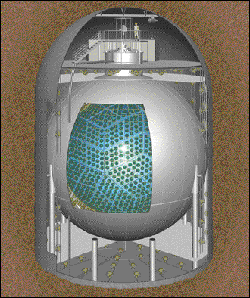
Neutrino Detector Focuses on Earth
Daniel S. Burgess
A team of 87 scientists from Japan, the US, China and France has reported the results of its study of electron antineutrinos produced in the Earth by radioactive decay. Its findings confirm that the Kamioka liquid scintillator antineutrino detector, or KamLand, offers earth scientists a unique tool to test their models of the interior of the planet.

The Kamioka liquid scintillator antineutrino detector, or KamLand, has demonstrated the sensitivity to measure the electron antineutrinos generated by the decay of uranium-238 and thorium-232 in the Earth. The detector's array of nearly 2000 photomultiplier tubes monitors a vat of 1000 tons of liquid scintillator for flashes of light resulting from the collision of an antineutrino and a proton. Courtesy of the KamLand collaboration.
From its vantage in a mine under Mount Ikenoyama in Japan, KamLand uses 1325 17-in. and 554 20-in. photomultiplier tubes from Hamamatsu Photonics KK of Hamamatsu, Japan, to detect the telltale signs of electron antineutrinos in a 1000-ton vat of liquid scintillator. Besides demonstrating its value as a tool for investigating phenomena such as neutrino mass and oscillation, the detector has now proved itself sufficiently sensitive to measure the antineutrinos produced by uranium-238 and thorium-232 as they decay to lead-206 and -208, respectively.
The decay chains of these isotopes are of interest to geologists because they offer insight into the 31 or 44 TW, depending on the interpretation of borehole data, radiated from Earth into space. Most of the terrestrial heat should be the result of the decay of 238U and 232Th. Estimates of the concentrations of these isotopes and models of mantle convection, however, have led scientists to conclude that they are responsible for only approximately 16 TW.
"This suggests there is a problem with the total heat flow measurement or the estimate of the radiogenic heating or the mantle convection model," explained Nikolai Tolich, a member of the KamLand collaboration from Lawrence Berkeley National Laboratory in California.
The ability to directly measure the antineutrinos generated by the decay of 238U and 232Th thus offers earth scientists a new and independent tool with which to calculate their contribution to terrestrial heat flow. During more than two years of observation using KamLand, the investigators report that they detected 4.5 to 54.2 likely geoneutrinos, consistent with geophysical models and corresponding to an upper limit of 60 TW for radiogenic heating by the decay chains.
Published: September 2005